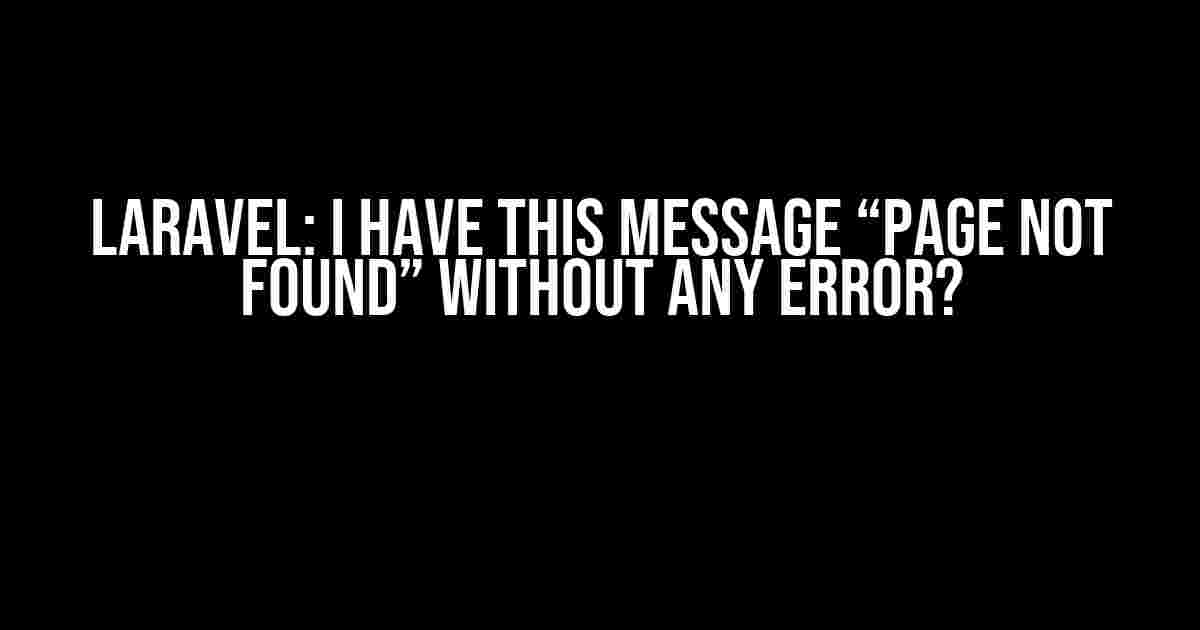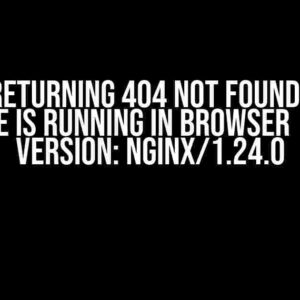Have you ever encountered the frustrating “Page Not Found” error in Laravel, only to find that there’s no error message to guide you towards a solution? Don’t worry, you’re not alone! This article will walk you through the most common reasons behind this issue and provide you with a step-by-step guide to troubleshoot and fix the problem.
Why Does This Happen?
There are several reasons why you might encounter the “Page Not Found” error without any error message in Laravel. Here are some of the most common culprits:
- Route Issues: Misconfigured or missing routes can cause the “Page Not Found” error.
- Controller or Method Issues: If your controller or method is not properly defined or is throwing an exception, you might see this error.
- View Issues: Problems with your view files, such as invalid PHP code or incorrect file paths, can cause the error.
- Middleware Issues: Middleware can sometimes interfere with your requests, leading to the “Page Not Found” error.
- URL and Redirect Issues: Incorrect URL redirects or malformed URLs can cause this error.
- Server or Environment Issues: Sometimes, server or environment-related issues, such as incorrect virtual host configuration or PHP settings, can cause the error.
Step-by-Step Troubleshooting Guide
Let’s dive into the step-by-step troubleshooting process to identify and fix the issue:
Step 1: Check Your Routes
Verify that your routes are correctly defined in the `routes/web.php` file or other route files in your Laravel project:
// routes/web.php
Route::get('/example', 'ExampleController@index');
Make sure the route you’re trying to access exists and is correctly defined. You can use the `route:list` command in your terminal to list all your routes:
php artisan route:list
Step 2: Check Your Controller and Method
Verify that your controller and method are correctly defined and don’t throw any exceptions:
// app/Http/Controllers/ExampleController.php
namespace App\Http\Controllers;
use Illuminate\Http\Request;
class ExampleController extends Controller
{
public function index()
{
return view('example');
}
}
Check your controller and method for any syntax errors or logical mistakes. You can use the `debugbar` package to debug your Laravel application and identify any issues.
Step 3: Check Your View
Verify that your view file is correctly defined and doesn’t contain any syntax errors:
// resources/views/example.blade.php
<h1>Example View</h1>
Make sure your view file is in the correct location and is correctly referenced in your controller method.
Step 4: Check Your Middleware
Verify that your middleware is correctly defined and doesn’t interfere with your request:
// app/Http/Kernel.php
protected $middleware = [
\Illuminate\Foundation\Http\Middleware\CheckForMaintenanceMode::class,
\Illuminate\Foundation\Http\Middleware\ValidatePostSize::class,
\App\Http\Middleware\ExampleMiddleware::class,
];
Check your middleware for any logic errors or incorrect implementations.
Step 5: Check Your URL and Redirects
Verify that your URLs and redirects are correctly defined and don’t cause any issues:
// routes/web.php
Route::get('/example', 'ExampleController@index');
Route::get('/example Redirect', function () {
return redirect('/example');
});
Make sure your URLs and redirects are correctly defined and don’t cause any infinite redirects or loops.
Step 6: Check Your Server and Environment
Verify that your server and environment are correctly configured:
// .env
APP_URL=http://localhost:8000
Check your virtual host configuration, PHP settings, and Laravel environment settings to ensure they’re correct.
Solution: Resolve the Issue
Once you’ve identified the cause of the “Page Not Found” error, make the necessary changes to resolve the issue. Here are some common solutions:
- Update Your Routes: Correctly define or update your routes to match your controller and method.
- Fix Your Controller or Method: Correctly define or update your controller and method to handle the request.
- Update Your View: Correctly define or update your view file to display the correct content.
- Disable Middleware: Disable or update your middleware to prevent interference with your request.
- Update Your URL and Redirects: Correctly define or update your URLs and redirects to prevent infinite redirects or loops.
- Update Your Server and Environment: Correctly configure your server and environment settings to ensure proper Laravel functionality.
Conclusion
The “Page Not Found” error without any error message in Laravel can be frustrating, but by following this step-by-step guide, you should be able to identify and fix the issue. Remember to check your routes, controller and method, view, middleware, URL and redirects, and server and environment settings to ensure everything is correctly configured. With persistence and patience, you’ll be able to resolve the issue and get your Laravel application up and running.
| Reason | Solution |
|---|---|
| Route Issues | Update your routes to match your controller and method. |
| Controller or Method Issues | Fix your controller or method to handle the request. |
| View Issues | Update your view file to display the correct content. |
| Middleware Issues | Disable or update your middleware to prevent interference. |
| URL and Redirect Issues | Update your URLs and redirects to prevent infinite redirects or loops. |
| Server or Environment Issues | Update your server and environment settings to ensure proper Laravel functionality. |
By following this guide, you’ll be able to troubleshoot and fix the “Page Not Found” error in Laravel, even without any error message. Happy coding!
Frequently Asked Question
Got stuck with the “Page Not Found” error in Laravel without any signs of life? Worry not, friend! We’ve got you covered with these frequently asked questions and their answers.
Q1: Is it possible that I made a mistake in my route declaration?
Yes, it’s highly likely! Double-check your route declaration to ensure it matches the requested URL. Make sure you haven’t mistyped the route name, method, or URL. Laravel is case-sensitive, so a small typo can lead to this error.
Q2: Could it be related to my controller or action?
Absolutely! Verify that your controller and action exist and are correctly defined. Ensure that your controller file is in the correct directory and the class and method names match the route declaration. Also, check for any typos or incorrect namespace declarations.
Q3: What about middleware? Could it be causing the issue?
Middleware can indeed cause this error. Review your middleware configurations to ensure they’re not blocking the request. Check the `kernel.php` file in the `app/Http` directory and verify that the middleware is properly registered and configured.
Q4: Is there a chance that my .env file is causing the problem?
It’s possible! The `.env` file can affect your application’s behavior. Ensure that your `.env` file is correctly configured and there are no syntax errors. Also, try clearing your application’s cache by running the `php artisan cache:clear` command to see if it resolves the issue.
Q5: What if I’ve tried everything and still getting the error?
Don’t worry, friend! If you’ve checked everything and still can’t find the issue, try enabling debug mode in your `.env` file by setting `APP_DEBUG=true`. This will give you more detailed error messages to help you identify the problem. If you’re still stuck, try searching online for similar issues or seeking help from the Laravel community.



